Homemade kimchi is easy on the wallet and it’s child’s play to make. If you’re unsure how to get started, then check out this beginner’s guide to making kimchi. We’ll show you how to make the best Korean pickles using everyday ingredients and no fancy equipment.
Basic Kimchi Recipe
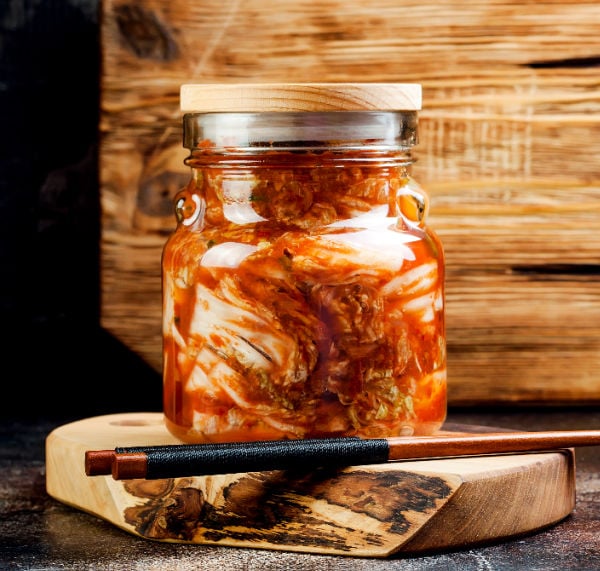
Follow these easy step-by-step instructions to make a mouth-watering batch of spicy, tangy kimchi. Although the fermenting time is at least two weeks, we assure you the wait is worthwhile.
Recommended equipment:
- Large bowl
- Colander
- Knife and chopping board
- Latex gloves
- Weight (such as pie weights)
- 2x ½ quart jars (or a one-quart jar)
- Plate for placing jars on during fermentation
Ingredients
- ¼ cup coarse sea salt
- 1 large napa cabbage
- 1 ½ cups daikon radish, cut into matchsticks
- 1 cup carrots, cut into matchsticks
- 7 garlic cloves
- 1 piece of fresh ginger, one-inch length
- 2 Tbsp fish sauce
- 5 Tbsp Gochujang paste
- 2 tsp sugar
Method
Step 1: Cabbage preparation
Remove two outer leaves and wrap in plastic before refrigerating for later use.
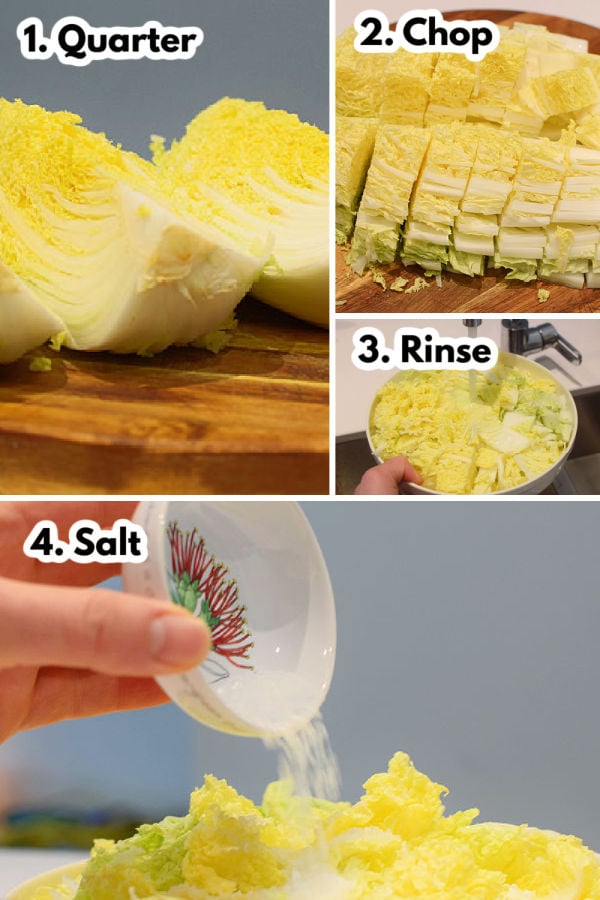
The steps to prep a napa cabbage for making kimchee.
Place the remaining cabbage on a chopping board and chop it into one-inch pieces, removing the stalk. Add to a large bowl and rinse with water to ensure all the leaves are wet. Toss with salt until evenly distributed.
Pour water into the bowl until the cabbage leaves are submerged then use a plate to keep everything underwater. Allow the cabbage to stand for 3 hours, stir, then stand for an extra 3 hours, or overnight.
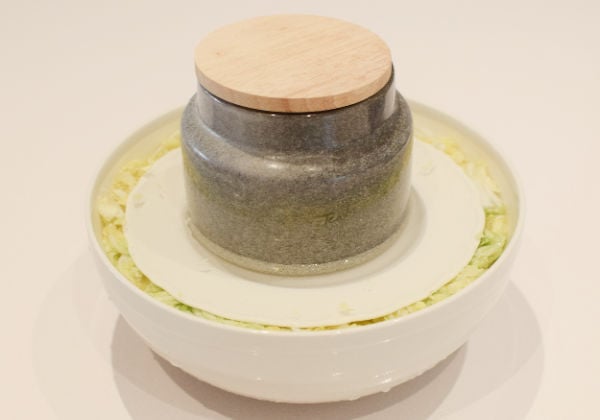
Make sure the napa cabbage is completely below the water.
Drain the brine into another container and set aside for later in the recipe. Give the cabbage a quick rinse then strain using a colander. Lay cabbage out on paper towels and dab dry. Return to the bowl and add daikon radish and carrots.
Related reading: Uses for leftover kimchi juice.
Step 2: Adding the paste
Add the garlic, ginger, fish sauce, gochujang paste, and sugar to a food processor. Pulse the ingredients until a thick paste forms.
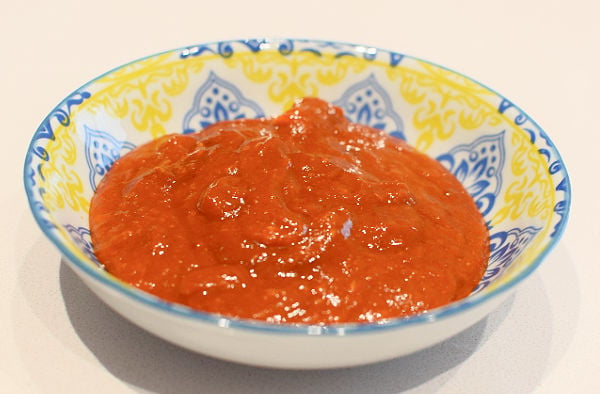
Freshly made sauce, ready to mix into the vegetables.
Slip on some gloves, then scoop out the paste and lather it onto the vegetables. Thoroughly massage it in with your hands until well coated.
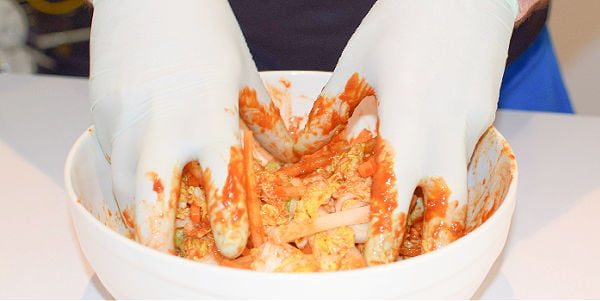
It's worth the effort to put on gloves before mixing kimchi.
Step 3: Jarring
Transfer the cabbage mixture into clean jars, making sure to leave two inches at the top. Pour in some of the leftover kimchi juice and press down the mixture until the vegetables are covered in liquid.
Fold up the cabbage leaf from the fridge and use it as a cover. Next, top with a fermentation weight such as a zip-lock bag filled with pie weights. This is important to keep all the solids underwater; otherwise, mold could develop and spoil the kimchi.
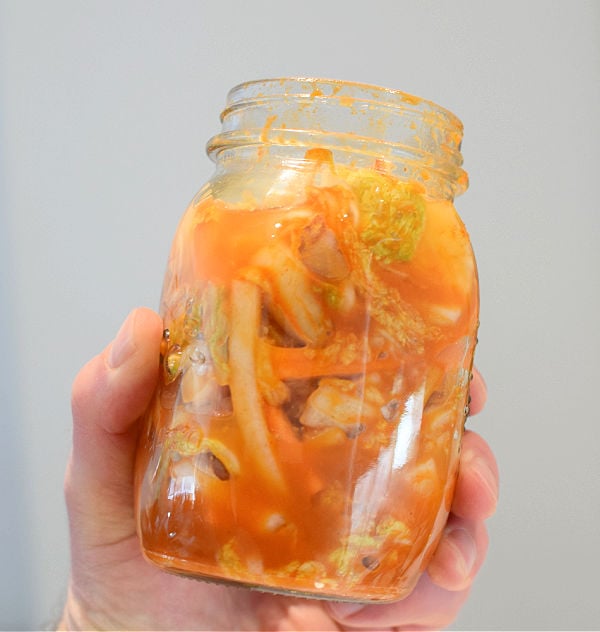
The kimchi is ready to start fermenting.
Step 4: Ambient fermentation
Place the jars on a large plate or baking tray so that any liquid that escapes is collected. Position a lid on each jar but leave a small gap to allow air to escape. Do not seal the lids.
Leave the kimchi for three days in a cool, dark place such as a basement or cupboard away from the oven or other hot appliances. The target temperature for fermenting kimchi is 55-65°F (12-18°C).
Step 5: Chilled fermentation
After 3 days of fermenting, check the jar for any sign of air bubbles. You may need to give the jar a tap to see them.
Can’t see any bubbles? Leave for another day and check again. Keep checking each day, keeping in mind that cooler climates take longer to ferment.
Bubbles can be seen? Transfer jars to the fridge and continue fermenting for a further 10-12 days. This will allow the flavors to develop complexity. The longer you allow the kimchi to ferment, the tangier the flavor will be.
You can keep the lid on loosely to allow the gas to escape or tighten the lid for a fizzier product. Remember to open the lid each week to allow the gas to escape.
Your kimchi is now ready to be eaten, enjoy!
Recipe notes
The cabbage: The ratios used in this kimchi recipe assume that one large napa cabbage weighs around 2 pounds. You can use two smaller ones.
Salt: The best salt for kimchi-making is Korean coarse salt (cheonilyeom) thanks to its excellent texture and minimal processing. If you can’t find any, then any sea salt will work well. Avoid harsh table salt.
The spicy stuff: Gochujang can be found in the Asian aisle of well-stocked supermarkets or online. Check out our article on gochujang substitutes here. For this recipe, we suggest using 4 tablespoons of gochugaru, aka Korean chili powder, as a good alternative. You can dial-up or down the gochujang or gochugaru depending on how hot you like your food.
Timing: If you enjoy extra tangy kimchi that’s softer in texture, add an extra 3-4 days to the room temperature fermentation.
Consistency: For kimchi with a thick consistency, cook one tablespoon of glutenous rice powder with a half cup of water in a small pot until boiling. Once cooled, blend into the chili paste when you process the other ingredients.
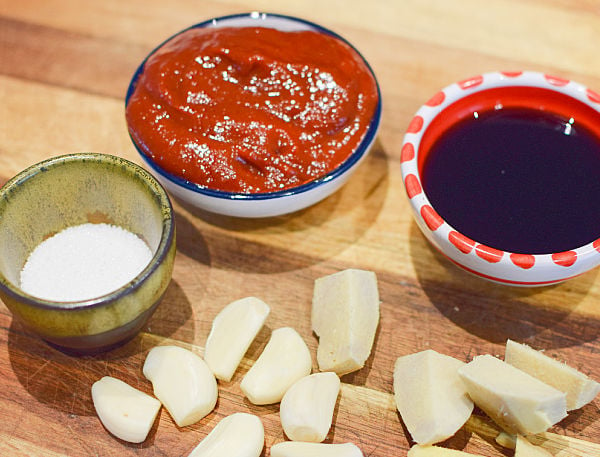
Gochujang, fish sauce, sugar, garlic, and ginger.
Temperature guidelines for fermenting kimchi
- The recommended temperature range for fermentation is 55-65°F (12-18°C).
- For best results, 65°F is ideal.
- Warm temps = faster fermentation. Cool temperatures = slower.
- At temperatures above 70°F, you may find the final flavor isn’t as good.
Related reading:
Ssamjang vs gochujang – what are the differences?
Troubleshooting kimchi problems
My kimchi isn’t bubbling! Use a thermometer to test the kimchi’s temperature. A reading outside of 50-70°F isn’t conducive to fermenting food.
My kimchi is too sticky! Sticky-textured kimchi can result from too much fresh ginger. Don’t be too aggressive with this spice.
My kimchi has mold! Mold will only develop if your kimchi is out of the water. If the top cabbage leaf has mold then discard it and wipe down the jar rim, before adding a new leaf.
My kimchi is too bitter! Using too much garlic can result in bitter kimchi so don’t go overboard on this ingredient.
What is kimchi?
Kimchi is a traditional Korean side dish and ingredient that is made from fermented vegetables like napa cabbage or Korean radish. It’s like sauerkraut, but spicier thanks to the addition of gochujang paste.
Countries outside of Korea are discovering why kimchi is loved by so many. Not only is it delicious, but it’s also packed with healthy probiotics, providing a range of health benefits.
If you’ve paid a visit to the refrigerated section at your local grocery store, you may have discovered a growing range of kimchi products. They’re convenient but aren’t cheap.
How to store kimchi
Kimchi should be stored in the refrigerator in its original jar with the lid on securely. It will last for 2-3 months if a clean spoon is used each time it is used. It’s also important to keep the vegetables pushed down below the liquid to prohibit mold growth.
Ingredient variations
Kimchi is only limited by the home chef’s imagination. Some popular ingredients that work great in kimchi include napa cabbage, white radish, gegeol radish, ponytail radish, yeolmu radish, daikon radish, cucumber, and mustard leaf.
If you’d like to make vegan kimchi then replace the fish sauce with soy sauce, miso paste, liquid aminos, or a vegan-friendly fish sauce.
7 ideas for fermentation weights
Here is a list of handy ways to weigh down the vegetables so that they stay below the waterline. If you use multiple small items like pie weights, then you can put them in a silicone cupcake liner.
- Fermentation weights
- Pie weights
- Whiskey stones
- Glass fermentation weights
- Small glass or jar
- Plate (if fermenting in a pot)
- Zip-lock bag filled with brine
Kimchi serving ideas
Authentic Korean cooks often serve kimchi as a side at dinner time. It is popular for adding to bibimbap or incorporated into pancakes, dumplings, fried rice, burritos, soups, stews, and noodles (guksu).
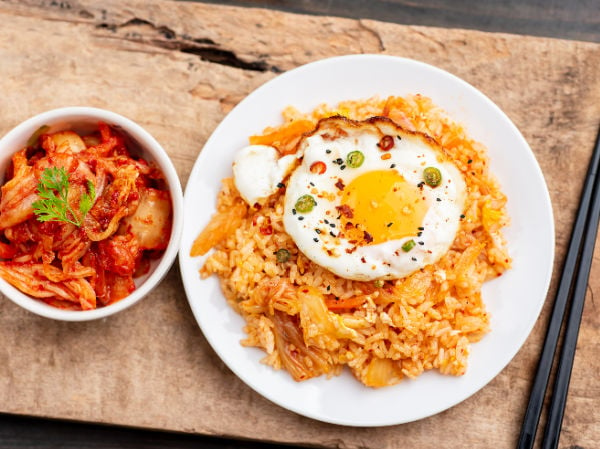
Kimchi is an versatile side dish.
Nutritional benefits of kimchi
Dieticians consider kimchi a very healthy food as it contains healthy bacteria (probiotics) which help with gut health. It is also a rich source of vitamins A, B, C, and K as well as iron, calcium, and phosphorous.
Commonly asked questions
Why do I need to sprinkle the chopped cabbage with water before salting?
Water speeds up the process of osmosis, encouraging the liquid to be expelled from the leaves.
What should I do if my finished kimchi develops a white coating on top?
This is mold that shouldn’t be consumed. It can be scraped off and discarded, while the rest should be good to eat.
Can I use seafood during the fermentation of kimchi?
Seafood like squid, mussels, or oysters is perfect for fermenting. Koreans call it jeotgal and it adds another dimension of flavor to the kimchi. Always use fresh seafood that hasn’t been sitting in the fridge for days.
What does kimchi taste like?
Kimchi is a flavor-packed pickled food that is salty, sour, and spicy all in one mouthful. It has a similar slightly crunchy texture as sauerkraut but is spicier with more umami flavor.
Can I buy kimchi from the store?
Flavor-wise, it’s fine to buy store-bought kimchi. The refrigerated products sold in grocery stores contain healthy gut bacteria that provide health benefits. Commercial products often contain preservatives such as nitrates.
Do I need an airlock for kimchi?
An airlock is not an essential piece of equipment for making kimchi, but it makes fermentation easier and often results in a better-tasting product.
Do I need to salt the cabbage?
Salt plays a crucial role in the fermentation process. It helps break down the walls of the cabbage leaves and releases brine.
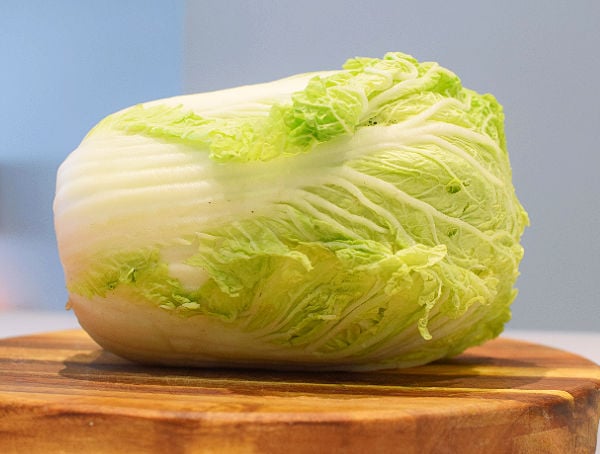
Salting the cabbage is an important step before fermenting.
Related recipes: If you enjoy DIY food projects then you may want to check out our complete guides to making cheddar cheese or ice cream. They offer more easy ways to save money producing your own food.
Summing up
Kimchi is a versatile food that adds amazing salty, tang to dishes. Even if you have little or no experience in Korean cooking, you can mix up a batch at home in minutes. The hardest part is waiting for the vegetables to ferment!
Everyone’s tastes are different so feel free to adjust the ingredient amounts in the recipe we provided. For example, if you don’t like food too hot then reduce the gochujang. If you like a little sweetness then include some apple, Asian pear, or regular pear.

Leave a Reply